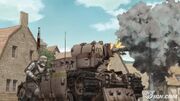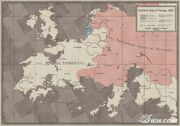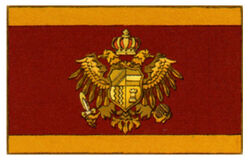| "Forward we march To conquer those who defile the graves of our fathers For the everlasting glory of the Emperor, king of kings" -Excerpt from the anthem of the East Europan Imperial Alliance- |
The Autocratic East Europan Imperial Alliance is one of two major world powers in the Valkyria Chronicles universe and the main enemy of Gallia in Valkyria Chronicles and Valkyria Chronicles 3.
Overview

An Imperial soldier supporting a light tank
A conglomerate of nations united under the rule of the East Europan Emperor, commonly referred to as "The Empire."
The Industrial Revolution that occurred when ragnite was discovered as a useful energy source saw the nations of eastern Europa, pioneers in machine technology, rise to power. Already tightly bound by a network of marriages amongst their royalty, these nations now joined hands in a formal international alliance.
While not technically an autocracy, the emperor enjoys limitless authority within the alliance. The Empire retains customs and practices held over from medieval times, and its people are known to harbor conservative views including a strong hatred for the Darcsen race, who are often put into forced labor camps to provide labour and materials for the Empire.
The culture of the Imperial Alliance still has strong roots in medieval times. This influence can be seen in the armor that the soldiers wear, and in in the vows of fealty that each soldier makes to the king.
Military
The Empire places a heavy emphasis on armor and large caliber weapons, with many of its tanks greatly out-massing their Federation and Gallian counterparts. The latest weapons developed by the Empire include a variety of superheavy tanks (Batomys-class) and even a terrestrial dreadnaught, Marmota.
Second Europan War

The Empire's territory circa 1935, colored red.

Map of the Empire, post-EWII
The Empire declared war on the Federation after the scarcity of Ragnite elevated tensions, sparking the Second Europan War. The Empire used its military superiority to quickly put the Federation on the defensive. Emboldened by their progress and momentum, the Empire decided to invade the neutral Principality of Gallia presumably in order to seize its rich Ragnite deposits. The invasion force was led personally by Prince Maximilian and his Drei Stern, but was eventually defeated through the efforts of the Gallian militia. After the Empire's invasion failed, the Federation launched a counterattack, succeeding in advancing deep into the Empire's territories in the northeast. Nevertheless, the Empire still controlled a large swath of Federation territory in the south and the two sides remain deadlocked.
After the War
After the Second Europan War, the Empire signed a treaty ending its war with Gallia. As part of the agreement, members of the Imperial nobility were sent to Gallia ostensibly to help further ties between the two nations. In reality, they were hostages against any new attempts by the Empire to invade.
Prominent Members
- Drei Stern
- Maximilian
- Selvaria Bles
- Berthold Gregor
- Radi Jaeger
- Calamity Raven
- Helmut Bourdais
Real-World References
- The Empire references several modern powers, mostly totalitarian, including but not limited to the Soviet Union, Nazi Germany, Imperial Germany, Tsarist Russian and the Austro-Hungarian Empire.
- The Empire's territories cover a similar area to that held by the Warsaw Pact during the Cold War.
- Imperial vehicles are armed with weapons using the same calibers as the Soviet Union's.
- The Empire's invasion of Gallia is reminiscent of the German invasion of Belgium in both 1914 and 1940, as well as the German invasion of the Netherlands in 1940.
- There are a number of references to Nazi Germany in the Empire.
- Many of its weapons are based on real-world weapons used by the Germans during WW2. For example, the ZM Kar has a similar name to the Karabiner 98 and 43 rifles, commonly shortened to Kar, and the ZM MP models are visually based on the MP 40 SMG, appearing practically identical from the trigger guard back.
- The Empire's cruel treatment of Darcsens reflects part of the treatment that Jews and various other "undesirables" suffered at the hands of the Nazi regime.
- The many eagles seen on Imperial uniforms, the eagle being a symbol of Nazi Germany.
- Several Imperial characters wear holsters for German Luger pistols, such as Gregor.
- It also bears resemblance to the Central Powers of Austria-Hungary and the German Empire with the latter being hinted at by the overview.
- They were all Absolutist, Militarist Monarchies with expansionist and imperial designs.
- The ZM SG rifle bears a visual similarity to the Mannlicher designs issued by Austria-Hungary and later their successor states, such as the 35M Puska and a model briefly fielded by the German Empire during the 1890s.
- The Imperial coat of arms is also vaguely similar to the Double-headed Eagle that was the coat of arms of Austria-Hungary, Prussia/Imperial Germany, Byzantine Empire, Russian Empire etc., although it bears the most resemblance to the one on the flag of the Greek Orthodox Church.
- The Army of the German Empire also issued armour to its troops during the First World War, but to a much lesser degree.
- At least three of the Empire's arms companies are named after real manufacturers; Krimm is named after Krupp, Mustela after Mauser, Tula after the Tula Arsenal (better known by the name TOZ).
- The reference to the Emperor as the "King of Kings" (or Padishah) echoes the traditional title of the Persian and Ottoman rulers, who were seen as diametric opposites of and threats to Western Civilization in its' Greek cradle. Seeing as how Eastern European Imperial Alliance actually references multitude of Eastern European states and not the Ottomans or Persians, the motto most likely comes from the Byzantine Palaiologos dynasty's imperial motto "Basileus Basileon Basileuon Basileuonton" (King of Kings, ruling over Kings).

